#zakmedios
Photo

https://www.zakmedios.com
Zakmedios is a Corporate Video Makers in Delhi NCR, Corporate Ad Film Makers in Delhi NCR, Corporate Film Makers in Delhi NCR, Top Corporate Video,Ad Film Makers in Delhi NCR,Noida,Gurgaon,India
#miningmonk#robots#manojkumarpachaury#zakmedios#corporate video makers in delhi ncr#corporate film maker in delhi ncr#corporate ad films maker in delhi ncr#https://www.zakmedios.com
0 notes
Link
Corporate Video Makers in Delhi, Coporate video production in Delhi, Corporate Video Production House in Delhi, Testimonial Videos Makers in Delhi, Product Description Video Makers in Delhi, Web Anchor Video Makers in Delhi, Digital Marketing Video Makers in Delhi,Animation Video Makers in Delhi,
https://corporatevideomakers.tumblr.com,
8 notes
·
View notes
Text
Safety Lamp
A safety lamp is any of several types of lamp that provides illumination in coal mines and is designed to operate in air that may contain coal dust or gases, both of which are potentially flammable or explosive. Until the development of effective electric lamps in the early 1900s, miners used flame lamps to provide illumination. Open flame lamps could ignite flammable gases which collected in mines, causing explosions; safety lamps were developed to enclose the flame and prevent it from igniting the surrounding atmosphere. Flame safety lamps have been replaced in mining with sealed explosion-proof electric lights.
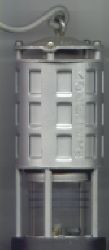
Damps or gases
Miners have traditionally referred to the various gases encountered during mining as damps, from the Middle Low German word dampf (meaning "vapour").Damps are variable mixtures and are historic terms.
Firedamp – Naturally occurring flammable mixtures, principally methane.
Blackdamp or Chokedamp – Nitrogen and carbon dioxide with no oxygen. Formed by complete combustion of firedamp or occurring naturally. Coal in contact with air will oxidize slowly and, if unused workings are not ventilated, pockets of blackdamp may develop. Also referred to as azotic air in some 19th-century papers.
Whitedamp – Formed by the incomplete combustion of coal, or firedamp. The mixture may contain significant amounts of carbon monoxide, which is toxic and potentially explosive.
Stinkdamp – Naturally occurring hydrogen sulphide and other gases. The hydrogen sulphide is highly toxic, but easily detected by smell. The other gases with it may be firedamp or blackdamp.
Afterdamp – The gas from an explosion of firedamp or coal dust. Contains varying proportions of blackdamp and whitedamp and is therefore suffocating, toxic, or explosive, or any combination of these. Afterdamp may also contain stinkdamp. Afterdamp may be a bigger killer following an explosion than the explosion itself.
Open flame illumination
Before the invention of safety lamps, miners used candles with open flames. This gave rise to frequent explosions. For example, at one colliery (Killingworth) in the north east of England, 10 miners were killed in 1806 and 12 in 1809. In 1812, 90 men and boys were suffocated or burnt to death in the Felling Pit near Gateshead and 22 in the following year.
Wood 1853 describes the testing of a mine for firedamp. A candle is prepared by being trimmed and excess fat removed. It is held at arm's length at floor level in one hand, the other hand shielding out all except the tip of the flame. As the candle is raised the tip is observed and if unchanged the atmosphere is safe. If however the tip turns bluish-gray increasing in height to a thin extended point becoming a deeper blue, then firedamp is present.Upon detecting firedamp the candle is lowered and arrangements made for the ventilating of the area or the deliberate firing of the firedamp after the end of a shift. A man edged forward with a candle on the end of a stick. He kept his head down to allow the explosion to pass over him, but as soon as the explosion had occurred stood upright as much as possible to avoid the afterdamp. Officially known as a fireman he was also referred to as a penitent or monk from the hooded garb he wore as protection. The protective clothing was made of wool or leather and well dampened. As can be imagined this procedure did not always preserve the life of the man so employed.
When they came into regular use, barometers were used to tell if atmospheric pressure was low which could lead to more firedamp seeping out of the coal seams into the mine galleries. Even after the introduction of safety lamps this was still essential information, see Trimdon Grange for details of an accident where pressure was involved.
The lack of good lighting was a major cause of the eye affliction nystagmus. Miners working in thin seams or when undercutting the coal had to lie on their side in cramped conditions. The pick was swung horizontally to a point beyond the top of their head. In order to see where they were aiming (and accurate blows were needed), the eyes needed to be straining in what would normally be the upwards and slightly to one side direction.This straining led first to temporary nystagmus and then to a permanent disability. Mild nystagmus would self-correct if a miner ceased to perform this work but if left untreated would force a man to give up mining. The lower levels of light associated with safety lamps caused an increase in the incidence of nystagmus.
First attempts at safe lamps
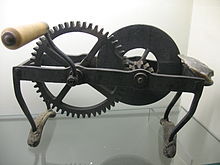
Both on the continent of Europe and in the UK dried fish skins were used. From them a faint bioluminescence (often called phosphorescence) occurs. Another safe source of illumination in mines was bottles containing fireflies.
Flint and steel mills introduced by Carlisle Spedding (1696-1755) before 1733 had been tried with limited success. An example of a Spedding steel mill may be seen in the museum at Whitehaven where Spedding was manager of the collieries of Sir James Lowther, 4th Baronet. A steel disk was rotated at high speed by a crank mechanism. Pressing a flint against the disk produced a shower of sparks and dim illumination. These mills were troublesome to use and were often worked by a boy, whose only task was to provide light for a group of miners. It was assumed that the sparks had insufficient energy to ignite firedamp until a series of explosions at Wallsend colliery in 1784; a further explosion in June 1785 which the operator of the mill (John Selkirk) survived showed that ignition was possible.
The first safety lamp made by William Reid Clanny used a pair of bellows to pump air through water to a candle burning in a metal case with a glass window. Exhaust gases passed out through water. The lamp gave out only a weak light though it was intrinsically safe provided it was kept upright. It was heavy and ungainly and required a man to pump it continuously. It was not a practical success and Clanny subsequently changed the basis of operation of later lamps in the light of the Davy and Stephenson lamps.
Oil lamps
Principles of operation
Safety lamps have to address the following issues:
Provide adequate light
Do not trigger explosions
Warn of a dangerous atmosphere
Fire requires three elements to burn: fuel, oxidant and heat; the triangle of fire. Remove one element of this triangle and the burning will stop. A safety lamp has to ensure that the triangle of fire is maintained inside the lamp, but cannot pass to the outside.
Fuel – there is fuel in the form of oil inside the lamp and fuel in the form of firedamp or coal dust outside.
Oxidant – there is an oxidant in the form of air present outside the lamp. The design of the lamp must allow the oxidant to pass into the lamp (and therefore exhaust gases to escape) or else the lamp will extinguish.
Heat – heat can be carried by the exhaust gases, through conduction and through burning of firedamp drawn into the lamp passing back down the inlet. Control of the transfer of heat is the key to manufacturing a successful safety lamp.
In the Geordie lamp, the inlet and exhausts are kept separate. Restrictions in the inlet ensure that only just enough air for combustion passes through the lamp. A tall chimney contains the spent gases above the flame. If the percentage of firedamp starts to rise, less oxygen is available in the air and combustion is diminished or extinguished. Early Geordie lamps had a simple pierced copper cap over the chimney to further restrict the flow and to ensure that the vital spent gas did not escape too quickly. Later designs used gauze for the same purpose and also as a barrier in itself. The inlet is through a number of fine tubes (early) or through a gallery (later). In the case of the gallery system air passes through a number of small holes into the gallery and through gauze to the lamp. The tubes both restrict the flow and ensure that any back flow is cooled. The flame front travels more slowly in narrow tubes (a key Stephenson observation) and allows the tubes to effectively stop such a flow.
In the Davy system, a gauze surrounds the flame and extends for a distance above forming a cage. All except the very earliest Davy lamps have a double layer at the top of the cage. Rising hot gases are cooled by the gauze, the metal conducting the heat away and being itself cooled by the incoming air. There is no restriction on the air entering the lamp and so if firedamp is entrained it will burn within the lamp itself. Indeed, the lamp burns brighter in dangerous atmospheres thus acting as a warning to miners of rising firedamp levels. The Clanny configuration uses a short glass section around the flame with a gauze cylinder above it. Air is drawn in and descends just inside the glass, passing up through the flame in the centre of the lamp.
The outer casings of lamps have been made of brass or tinned steel. If a lamp bangs against a hard piece of rock, a spark could be generated if iron or untinned steel were employed.

Examples of lamps
Davy lamp
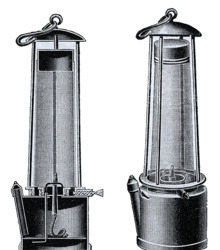
In the Davy lamp a standard oil lamp is surrounded by fine wire gauze, the top being closed by a double layer of gauze.
If firedamp is drawn into the flame it will burn more brightly and if the proportions are correct may even detonate. The flame on reaching the gauze fails to pass through and so the mine atmosphere is not ignited. However, if the flame is allowed to play on the gauze for a significant period, then it will heat up, sometimes as far as red heat. At this point it is effective, but in a dangerous state. Any further increase in temperature to white heat will ignite the external atmosphere. A sudden draught will case a localised hot spot and the flame will pass through. At a draught of between 4 and 6 feet per second the lamp becomes unsafe. At Wallsend in 1818 lamps were burning red hot (indicating significant firedamp).
A boy (Thomas Elliott) was employed to carry hot lamps to the fresh air and bring cool lamps back. For some reason he stumbled; the gauze was damaged and the damaged lamp triggered the explosion.
At Trimdon Grange (1882) a roof fall caused a sudden blast of air and the flame passed through the gauze with fatal results (69 killed).
Stephenson ("Geordie") lamp
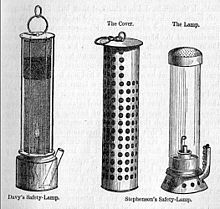
A development of the Geordie lamp was the Purdy. A galley with gauze provided the inlet, above the glass was a chimney with perforated copper cap and gauze outer. A brass tube protected the upper works, shielded them and kept them locked in position. A sprung pin locked the whole together. The pin could only be released by applying a vacuum to a captive hollow screw; not something that a nicotine starved miner could do at the coal face.
Mueseler lamp
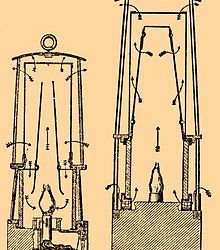
The lamp is a modified Clanny designed by the Belgian Mathieu-Louis Mueseler. The flame is surrounded by a glass tube surmounted by a gauze capped cylinder. Air enters from the side above the glass and flows down to the flame before rising to exit at the top of the lamp. So far this is just a Clanny, but in the Mueseler a metal chimney supported on an internal gauze shelf conducts the combustion products to the top of the lamp. Some Mueseler lamps were fitted with a mechanism which locked the base of the lamp. Turning down the wick eventually released the base, but by then the flame was extinguished and therefore safe.
The lamp was patented in 1840 and in 1864 the Belgian government made this type of lamp compulsory.
In the presence of firedamp the explosive mixture is drawn through two gauzes (cylinder and shelf), burnt and then within the chimney are only burnt gases, not explosive mixture. Like a Clanny, and the Davy before it, it acts as an indicator of firedamp, burning more brightly in its presence. Later models had graduated shields by which the deputy could determine the concentration of firedamp from the heightening of the flame. Whilst the Clanny will continue to burn if laid on its side, potentially cracking the glass; the Mueseler will extinguish itself due to the stoppage of convection currents. The lamp is safe in currents up to 15 feet per second.
Landau's lamp
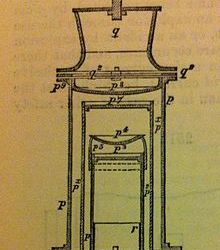
The lamp is in part a development of the Geordie. Air enters into a ring near the base which is protected by gauze or perforated plate. The air passes down the side of the lamp passing through a series of gauze covered holes and enters the base through another yet another series of gauze covered holes. Any attempt to unscrew the base causes the lever (shown at f in the illustration) to extinguish the flame. The gauze covered holes and passageways restrict the flow to that required for combustion, so if any part of the oxygen is replaced by firedamp, then the flame is extinguished for want of oxidant.
The upper portion of the lamp uses a chimney like Mueseler and Morgan lamps. The rising gases pass up the chimney and through a gauze. At the top of the chimney a dished reflector diverts the gases out sideways through a number of holes in the chimney. The gases then start to rise up the intermediate chimney before exiting through another gauze. Gas finally passes down between the outermost chimney and the intermediate chimney, exiting a little above the glass. The outer chimney is therefore effectively a shield.
Yates' lamp
The Yates lamp is a development of the Clanny. Air enters through the lower part of the gauze top and leaves through the upper part; there is no chimney. The lower glass part of the lamp has seen some development however. It is replaced by a silvered reflector having a strong lens or bull's-eye in it to allow the light out. The result was a claimed 20 fold improvement in lighting over the Davy. Yates claimed "the temptation to expose the flame to obtain more light is removed".
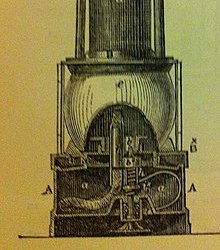
The base also contained an interlocking mechanism to ensure that the wick was lowered and the lamp extinguished by any attempt to open it.
The lamp was "much more expensive than the forms of lamp now in general use, but Mr, Yates states that the saving of oil effected by its use will in one year pay the additional cost".
#miningmonk#talktomanojpachaury#manoj#manojkumarpachauri#theonlydaizy#kunikasok#ashokkumarpachauri#daizytbp#zakmedios#mining#lamphandling#lampsanditstypes#typesoflamps#safetylamps#Yates' lamp#Clifford#Landau's Lamp#https://www.zakmedios.com#theonlydaizy.in#ashokpachauri#ashwanikumarsaraswat
0 notes
Link
Corporate Video Makers in Delhi, Coporate video production in Delhi, Corporate Video Production House in Delhi, Testimonial Videos Makers in Delhi, Product Description Video Makers in Delhi, Web Anchor Video Makers in Delhi, Digital Marketing Video Makers in Delhi,Animation Video Makers in Delhi
1 note
·
View note
Link
Corporate Video Makers in Delhi, Coporate video production in Delhi, Corporate Video Production House in Delhi, Testimonial Videos Makers in Delhi, Product Description Video Makers in Delhi, Web Anchor Video Makers in Delhi, Digital Marketing Video Makers in Delhi,Animation Video Makers in Delhi
0 notes
Link
Corporate Video Makers in Delhi, Coporate video production in Delhi, Corporate Video Production House in Delhi, Testimonial Videos Makers in Delhi, Product Description Video Makers in Delhi, Web Anchor Video Makers in Delhi, Digital Marketing Video Makers in Delhi,Animation Video Makers in Delhi
0 notes
Link
Corporate Video Makers in Delhi, Coporate video production in Delhi, Corporate Video Production House in Delhi, Testimonial Videos Makers in Delhi, Product Description Video Makers in Delhi, Web Anchor Video Makers in Delhi, Digital Marketing Video Makers in Delhi,Animation Video Makers in Delhi
0 notes
Link
Corporate Video Makers in Delhi, Coporate video production in Delhi, Corporate Video Production House in Delhi, Testimonial Videos Makers in Delhi, Product Description Video Makers in Delhi, Web Anchor Video Makers in Delhi, Digital Marketing Video Makers in Delhi,Animation Video Makers in Delhi
0 notes
Link
Corporate Video Makers in Delhi, Coporate video production in Delhi, Corporate Video Production House in Delhi, Testimonial Videos Makers in Delhi, Product Description Video Makers in Delhi, Web Anchor Video Makers in Delhi, Digital Marketing Video Makers in Delhi,Animation Video Makers in Delhi
0 notes